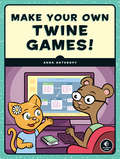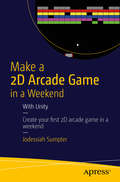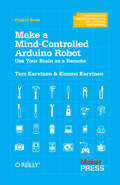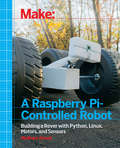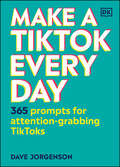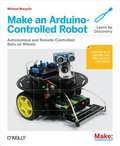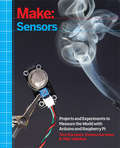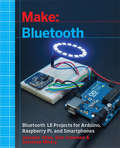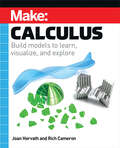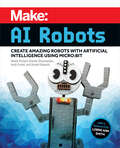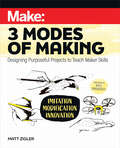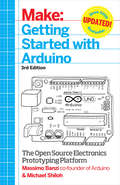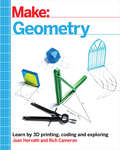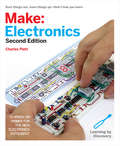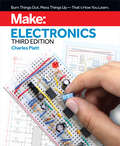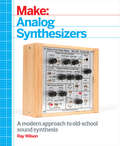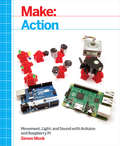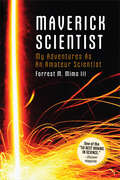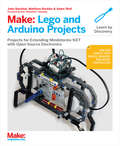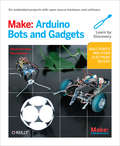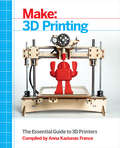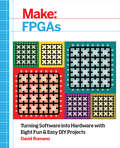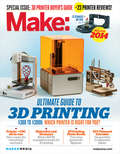- Table View
- List View
Make Your Own Twine Games!
by Anna AnthropyBring your game ideas to life with Twine! Twine is a free online tool that lets anyone new to programming create their own interactive, story-based adventure games in a web page. In Make Your Own Twine Games!, game designer Anna Anthropy takes you step-by-step through the game development process, from coming up with a basic idea to structuring your game. You’ll learn the basics of Twine like how to use links and apply images and formatting to make your game look more distinct. You’ll get tips on how to test your game, export it, and publish it online, and even understand more advanced features like scripting to get your game to remember and respond to player choices. As you make your way through the book and begin crafting your own interactive fiction, you’ll learn other cool tricks like how to:• Write stories that follow multiple paths using hyperlinks• Create variables to track your player’s actions• Add scripting like “if” and “else” to decide when ghosts should appear in your game• Use hooks to add fancy touches like text effects, pictures, and sound With example games to act as inspiration, Make Your Own Twine Games! will take you from story-teller to game designer in just a few clicks! Ready player one? The game starts now.Covers Twine 2
Make a 2D Arcade Game in a Weekend
by Jodessiah SumpterCreate and complete your first 2D arcade game in Unity. In Make a 2D Arcade Game in a Weekend with Unity, you will learn to create an arcade classic brick breaker game from beginning to end. You will plan the game flow, add the graphics and create the game logic using C#, then build the UX to complete your game. By the time you have finished, you will have enough knowledge to tweak the game to create more levels or your own variant game rules, and you will have the confidence to go on and create your own 2D arcade games. You will also learn how to publish the game into mobile app stores. Unity is a powerful cross platform software tool that allows you to create 2D and 3D apps and games. Learning how to create a classic arcade game is a great way to learn the foundations of game design. While you do need to have a basic understanding of Unity to complete this project, advanced game building or advanced Unity experience is not required. What you'll learn Learn how to design a classic arcade puzzle game with a unique twist Navigate the Unity game development platform Gain knowledge and experience scripting in C# Add power-ups and scoring to a game Learn tips for shortening the development timeline Deploy your game using Unity Cloud Build Who this book is for Make a 2D Arcade Game in a Weekend with Unity is for readers who are interested in learning the basic concepts of game development. Make a 2D Arcade Game in a Weekend with Unity is an excellent choice for the beginner game developer or novice mobile app developer to learn how to build a classic arcade game in a short period of time. Table of Contents 1. Getting Started 2. Define Game Layout and Environment 3. Create Positioning and Movement 4. Scripting a Game Manager 5. Adding Sound and Music 6. Game Power Ups 7. Level Manager and Menu 8. Publishing to the App Store
Make a 2D RPG in a Weekend
by Darrin PerezMake a 2D RPG in a Weekend shows you how to create your very own dungeon crawler game in RPG Maker VX Ace in a single weekend. The entire process, from start to finish, is covered within this book. You will see a variety of dungeon maps and events, all broken down for your convenience. One of the hardest parts of game development is actually finishing a game, but it is also one of the most important steps on the way to becoming a game developer. If you have yet to finish a game, this book will give you the confidence and resources you need to finally be able to create your very own RPG. Once you've completed the game in this book, you'll be able to modify it as much as you like, adding new monsters and quests, and you'll have the skills to go on to create your second game all by yourself. Among the topics covered in this book are: * Creating various types of enemy encounters via the use of the eventing system. * Creating a special area that allows the player to pick their character of choice instead of being forced to play a particular character. * Clever uses of events to create items that allow the player to return to town instantly and summon vehicles to their side. What you'll learn * Create playable characters that have different attributes and playstyles. * Create a wide variety of weapons, armors, and items for the player to purchase, find, and use. * Design dungeon levels with specific goals in mind. * Create treasure chests with random contents or contents based on the player's character. * Create doors that require keys or puzzles to unlock. * Create a variety of enemy encounters. Who this book is for Make a 2D RPG in a Weekend is for anyone who has ever wanted to create a game from scratch. All you need is this book and a copy of RPG Maker VX Ace. Table of Contents Chapter 1: Laying Out the Framework Chapter 2: The Characters of our Game Chapter 3: The Upper Catacombs of Eagle's Crossing Chapter 4: Populating Eagle's Crossing Chapter 5: The Lower Catacombs of Eagle's Crossing Chapter 6: The Caves Chapter 7: The Pixie's Forest (West) Chapter 8: The Pixie's Forest (East) Chapter 9: The Ancient Temple Chapter 10: What Comes Next Chapter 11: Appendix
Make a Mind-Controlled Arduino Robot: Use Your Brain as a Remote
by Tero Karvinen Kimmo KarvinenBuild a robot that responds to electrical activity in your brain—it’s easy and fun. If you’re familiar with Arduino and have basic mechanical building skills, this book will show you how to construct a robot that plays sounds, blinks lights, and reacts to signals from an affordable electroencephalography (EEG) headband. Concentrate and the robot will move. Focus more and it will go faster. Let your mind wander and the robot will slow down.You’ll find complete instructions for building a simple robot chassis with servos, wheels, sensors, LEDs, and a speaker. You also get the code to program the Arduino microcontroller to receive wireless signals from the EEG. Your robot will astound anyone who wears the EEG headband.This book will help you:Connect an inexpensive EEG device to ArduinoBuild a robot platform on wheelsCalculate a percentage value from a potentiometer readingMix colors with an RGB LEDPlay tones with a piezo speakerWrite a program that makes the robot avoid boundariesCreate simple movement routines
Make a Raspberry Pi-Controlled Robot: Building a Rover with Python, Linux, Motors, and Sensors
by Wolfram DonatMake a Raspberry-Pi Controlled Robot teaches you how to build a capable and upgradeable personal robot for around $100. You'll learn how to control servos, respond to sensor input, and know where your bot is using GPS. You'll also learn many ways to connect to your robot and send it instructions, from an SSH connection to sending text messages from your phone.
Make a TikTok Every Day: 365 Prompts for Attention-Grabbing TikToks
by Dave JorgensonLife is short and so are TikToks, so what are you waiting for? Release your creativity with these 365 TikTok ideas.Making a TikTok video that goes viral is all about having a quirky idea that can grab attention in as little as 15 seconds. Whether you're a TikTok beginner or a practiced creator, the hardest part is often getting started. This unofficial book provides a year's worth of ideas in the form of creative prompts to keep you posting new videos every day. Give the weather report using the app's Green Screen effect.Use forced perspective and a coffee mug and make a splash as you dive in.Dance with your dog.Say nice things to a houseplant and see if it grows faster.Kick-start a new meme by creating a TikTok that people will want to "duet" with.There are tips and advice from the most popular creators, including the queen of Alt TikTok, Melissa Ong, wholesome TikTok family The McFarlands, and fashion favorite Jeffery Dang, who provide insight into their experience on the app and how they got started as creators.
Make an Arduino-Controlled Robot
by Michael Margolis<p>Building robots that sense and interact with their environment used to be tricky. Now, Arduino makes it easy. With this book and an Arduino microcontroller and software creation environment, you’ll learn how to build and program a robot that can roam around, sense its environment, and perform a wide variety of tasks.</p>
Make: A Hands-On Primer for Monitoring the Real World with Arduino and Raspberry Pi
by Tero Karvinen Kimmo Karvinen Ville ValtokariMake: Sensors is the definitive introduction and guide to the sometimes-tricky world of using sensors to monitor the physical world. With dozens of projects and experiments for you to build, this book shows you how to build sensor projects with both Arduino and Raspberry Pi. Use Arduino when you need a low-power, low-complexity brain for your sensor, and choose Raspberry Pi when you need to perform additional processing using the Linux operating system running on that device.You'll learn about touch sensors, light sensors, accelerometers, gyroscopes, magnetic sensors, as well as temperature, humidity, and gas sensors.
Make: Bluetooth LE Projects with Arduino, Raspberry Pi, and Smartphones
by Alasdair Allan Don Coleman Sandeep MistryThis book is where your adventures with Bluetooth LE begin. You'll start your journey by getting familiar with your hardware options: Arduino, BLE modules, computers (including Raspberry Pi!), and mobile phones. From there, you'll write code and wire circuits to connect off-the-shelf sensors, and even go all the way to writing your own Bluetooth Services. Along the way you'll look at lightbulbs, locks, and Apple's iBeacon technology, as well as get an understanding of Bluetooth security-- both how to beat other people's security, and how to make your hardware secure.
Make: Calculus
by Joan Horvath Rich CameronWhen Isaac Newton developed calculus in the 1600s, he was trying to tie together math and physics in an intuitive, geometrical way. But over time math and physics teaching became heavily weighted toward algebra, and less toward geometrical problem solving. However, many practicing mathematicians and physicists will get their intuition geometrically first and do the algebra later.Make:Calculus imagines how Newton might have used 3D printed models, construction toys, programming, craft materials, and an Arduino or two to teach calculus concepts in an intuitive way. The book uses as little reliance on algebra as possible while still retaining enough to allow comparison with a traditional curriculum.This book is not a traditional Calculus I textbook. Rather, it will take the reader on a tour of key concepts in calculus that lend themselves to hands-on projects. This book also defines terms and common symbols for them so that self-learners can learn more on their own.
Make: Create Amazing Robots with Artificial Intelligence Using micro:bit
by Reade Richard Brenda Shivanandan Andy Forest Denzel EdwardsArtificial intelligence is a tool to explore and create, and it starts here with the experts at Steamlabs, a nonprofit that teaches teens to not just be users of technology, but to create with technology so they can be help shape our future.Make: AI Robots introduces young people to AI through exciting craft projects that start with a mechanical cardboard creation, integrates fun electronic lights and motors, adds simple coding on a micro:bit, and then teaches how to train AI to create a spark of life.With 32 projects designed to guide beginners through increasing challenges, Make: AI Robots is the perfect way to feed curious minds with fun AI experiments that will delight and inspire.
Make: Designing Purposeful Projects to Teach Maker Skills
by Matt ZiglerThe Maker movement has been an excellent opportunity for people to become producers rather than just consumers, and schools are recognizing the value of offering students the tools, materials, and skills necessary to design sophisticated and meaningful projects. But teaching technical skills should not be the end goal: At its best, a Maker education teaches students to think and act in creative ways that can be applied to difficult challenges in all areas of life.Three Modes of Making provides a framework for Maker courses in upper grades that teach students creative-process skills through three key Maker modes: Imitation, Modification, and Innovation. Educators will learn the differences between the three Maker modes, their associated skill sets, and gain concrete methods to teach, document, and assess these skills. Through this approach, teachers will enable students to apply them to different creative needs.By focusing on how to teach skill development rather than merely how to build specific objects, Three Modes of Making enables students to improve and enhance their creative skills, and learn ways to apply them to a wide variety of challenges. This book is a road map to developing the creative problem solvers that the world needs for the future.
Make: Getting Started with Arduino
by Massimo Banzi Michael ShilohArduino is the hot open source prototyping platform for artists, hobbyists, students, and anyone who wants to create interactive physical environments. Getting Started with Arduino is co-authored by Arduino co-founder Massimo Banzi, and incorporates his experience in teaching, using, and creating Arduino.
Make: Learn by coding, 3D printing and building
by Joan Horvath Rich CameronGeometry, of all the branches of mathematics, is the one that is most easily visualized by making something. However, it is all too easy to reduce it to reams of formulas to memorize and proofs to replicate. This book aims to take geometry back to its practical roots with 3D printed models and puzzles as well as demonstrations with household objects like flashlights and paper towel tubes.This is not a traditional geometry textbook, but rather builds up understanding of geometry concepts while also bringing in elements of concepts normally learned much later. Some of the models are counterintuitive, and figuring out how and why they work will both entertain and give insights. Two final chapters suggesting open-ended projects in astronomy and physics, and art and architecture, allow for deeper understanding and integration of the learning in the rest of the book.
Make: Learning Through Discovery (Make Ser.)
by Charles Platt"This is teaching at its best!"--Hans Camenzind, inventor of the 555 timer (the world's most successful integrated circuit), and author of Much Ado About Almost Nothing: Man's Encounter with the Electron (Booklocker.com)"A fabulous book: well written, well paced, fun, and informative. I also love the sense of humor. It's very good at disarming the fear. And it's gorgeous. I'll be recommending this book highly."--Tom Igoe, author of Physical Computing and Making Things TalkA "magnificent and rewarding book. ... Every step of this structured instruction is expertly illustrated with photos and crisp diagrams. . . . This really is the best way to learn."--Kevin Kelly, in Cool ToolsThe first edition of Make: Electronics established a new benchmark for introductory texts. This second edition enhances that learning experience.Here you will find unique, photographically precise diagrams of breadboarded components, to help you build circuits with speed and precision. A new shopping guide and a simplified range of components, will minimize your investment in parts for the projects. A completely new section on the Arduino shows you how to write properly structured programs instead of just downloading other people's code. Projects have been reworked to provide additional features, and the book has been restructured to offer a step-by-step learning process that is as clear and visually pleasing on handheld devices as it is on paper. Full color is used throughout.As before, Make: Electronics begins with the basics. You'll see for yourself how components work--and what happens when they don't. You'll short out a battery and overheat an LED. You'll also open up a potentiometer and a relay to see what's inside. No other book gives you such an opportunity to learn from real-life experiences.Ultimately, you will build gadgets that have lasting value, and you'll have a complete understanding of how they work. From capacitors to transistors to microcontrollers--it's all here.Hans Camenzind, inventor of the 555 Timer (the world's most successful integrated circuit chip), said that "This is teaching at its best!" when he reviewed the first edition. Now the second edition offers even more!
Make: Learning by Discovery: A hands-on primer for the new electronics enthusiast
by Charles PlattMake: Electronics explores the properties and applications of discrete components that are the fundamental building blocks of circuit design. Understanding resistors, capacitors, transistors, inductors, diodes, and integrated circuit chips is essential even when using microcontrollers. Make: Electronics teaches the fundamentals and also provides advice on the tools and supplies that are necessary. Component kits are available, specifically developed for the third edition.
Make: Make Electronic Sounds the Synth-DIY Way
by Ray WilsonDive hands-on into the tools, techniques, and information for making your own analog synthesizer. If you’re a musician or a hobbyist with experience in building electronic projects from kits or schematics, this do-it-yourself guide will walk you through the parts and schematics you need, and how to tailor them for your needs. Author Ray Wilson shares his decades of experience in synth-DIY, including the popular Music From Outer Space (MFOS) website and analog synth community.At the end of the book, you’ll apply everything you’ve learned by building an analog synthesizer, using the MFOS Noise Toaster kit. You’ll also learn what it takes to create synth-DIY electronic music studio. Get started in the fun and engaging hobby of synth-DIY without delay.With this book, you’ll learn:The differences between analog and digital synthesizersAnalog synthesizer building blocks, including VCOs, VCFs, VCAs, and LFOsHow to tool up for synth-DIY, including electronic instruments and suggestions for home-made equipmentFoundational circuits for amplification, biasing, and signal mixingHow to work with the MFOS Noise Toaster kitSetting up a synth-DIY electronic music studio on a budget
Make: Movement, Light, and Sound with Arduino and Raspberry Pi
by Simon MonkBeginning with the basics and moving gradually to greater challenges, this book takes you step-by-step through experiments and projects that show you how to make your Arduino or Raspberry Pi create and control movement, light, and sound. In other words: action! The Arduino is a simple microcontroller with an easy-to-learn programming environment, while the Raspberry Pi is a tiny Linux-based computer. This book clearly explains the differences between the Arduino and Raspberry Pi, when to use them, and to which purposes each are best suited. Using these widely available and inexpensive platforms, you'll learn to control LEDs, motors of various types, solenoids, AC (alternating current) devices, heaters, coolers, displays, and sound. You'll even discover how to monitor and control these devices over the Internet. Working with solderless breadboards, you'll get up and running quickly, learning how to make projects that are as fun as they are informative. In Make: Action, you'll learn to: Build a can crusher using a linear actuator with your ArduinoHave an Arduino water your plantsBuild a personal traffic signal using LEDsMake a random balloon popper with ArduinoCool down your beverages with a thermostatic drink cooler you build yourselfUnderstand and use the PID control algorithmUse Raspberry Pi to create a puppet dance party that moves to your tweets!
Make: My Adventures as an Amateur Scientist
by Forrest M. MimsMaverick Scientist is the memoir of Forrest Mims, who forged a distinguished scientific career despite having no academic training in science. Named one of the "50 Best Brains in Science" by Discover magazine, Forrest shares what sparked his childhood curiosity and relates a lifetime of improbable, dramatic, and occasionally outright dangerous experiences in the world of science.At thirteen he invented a new method of rocket control. At seventeen he designed and built an analog computer that could translate Russian into English and that the Smithsonian collected as an example of an early hobby computer. While majoring in government at Texas A&M University, Forrest created a hand-held, radar-like device to help guide the blind. And during his military service, he had to be given special clearance to do top secret laser research at the Air Force Weapons Lab. Why? Because while he lacked the required engineering degree, they wanted his outside-the-box thinking on the project.He went on to co-found MITS, Inc., producer of the first commercially successful personal computer, wrote a series of electronics books for Radio Shack that sold more than seven million copies, and designed the music synthesizer circuit that became known as the infamous Atari Punk Console. All this came before he started consulting for NASA's Goddard Space Flight Center, and NOAA's famous Mauna Loa Observatory, and earning the prestigious Rolex Award.This intimate portrait of a self-made scientist shares a revelatory look inside the scientific community, and tells the story of a lifelong learner who stood by his convictions even when pressured by the establishment to get in line with conventional wisdom. With dozens of personal photos and illustrations, Maverick Scientist serves as proof that to be a scientist, you simply need to do science.
Make: Projects for extending MINDSTORMS NXT with open-source electronics
by Adam Wolf John Baichtal Matthew BecklerMake amazing robots and gadgets with two of today’s hottest DIY technologies. With this easy-to-follow guide, you’ll learn how to build devices with Lego Mindstorms NXT 2.0, the Arduino prototyping platform, and some add-on components to bridge the two. Mindstorms alone lets you create incredible gadgets. Bring in Arduino for some jaw-dropping functionality—and open a whole new world of possibilities.Build a drink dispenser, music synthesizer, wireless lamp, and moreEach fun and fascinating project includes step-by-step instructions and clear illustrations to guide you through the process. Learn how to set up an Arduino programming environment, download the sketches and libraries you need, and work with Arduino’s language for non-programmers. It’s a perfect book for students, teachers, hobbyists, makers, hackers, and kids of all ages.Build a Drawbot that roams around and traces its path with a marker penConstruct an analog Mindstorms clock with hands that display the correct timeCreate a machine that mixes a glass of chocolate milk at the touch of a buttonMake a Gripperbot rolling robotic arm that you control wirelessly with Arduinos mounted on your armsExplore electronic music by building a guitar-shaped Lego synthesizerBuild a Lego lamp with on/off and dimmer switches that you control with a smartphone applicationJump feet first into the world of electronics, from learning Ohm’s Law to working with basic componentsYou'll need the Bricktronics shield created for this book by Open Source Hardware kit maker Wayne and Layne, or you can build a breadboarded equivalent (see Chapter 10) for about $25 in parts.
Make: Six Embedded Projects with Open Source Hardware and Software
by Tero Karvinen Kimmo KarvinenWant to build your own robots, turn your ideas into prototypes, control devices with a computer, or make your own cell phone applications? It's a snap with this book and the Arduino open source electronic prototyping platform. Get started with six fun projects and achieve impressive results quickly.Gain the know-how and experience to invent your own cool gadgets.With Arduino, building your own embedded gadgets is easy, even for beginners. Embedded systems are everywhere—inside cars, children’s toys, and mobile phones. This book will teach you the basics of embedded systems and help you build your first gadget in just a few days. Each learn-as-you-build project that follows will add to your knowledge and skills.Experiment with Arduino, the popular microcontroller boardBuild robots and electronic projects with easy-to-follow instructionsTurn your ideas into working physical prototypesUse Android phones as remote controls in your projectsWork with an uncomplicated programming language created for artists, designers, and hobbyistsGet everyone involved, with projects that even beginners can build
Make: The Essential Guide to 3D Printers
by Anna Kaziunas FranceThe 3D printing revolution is well upon us, with new machines appearing at an amazing rate. With the abundance of information and options out there, how are makers to choose the 3D printer that's right for them? MAKE is here to help, with our Ultimate Guide to 3D Printing. With articles about techniques, freely available CAD packages, and comparisons of printers that are on the market, this book makes it easy to understand this complex and constantly-shifting topic.Based on articles and projects from MAKE's print and online publications, this book arms you with everything you need to know to understand the exciting but sometimes confusing world of 3D Printing.
Make: Turning Software into Hardware with Eight Fun and Easy DIY Projects
by David RomanoWhat if you could use software to design hardware? Not just any hardware--imagine specifying the behavior of a complex parallel computer, sending it to a chip, and having it run on that chip--all without any manufacturing? With Field-Programmable Gate Arrays (FPGAs), you can design such a machine with your mouse and keyboard. When you deploy it to the FPGA, it immediately takes on the behavior that you defined. Want to create something that behaves like a display driver integrated circuit? How about a CPU with an instruction set you dreamed up? Or your very own Bitcoin miner You can do all this with FPGAs. Because you're not writing programs--rather, you're designing a chip whose sole purpose is to do what you tell it--it's faster than anything you can do in code. With Make: FPGAs, you'll learn how to break down problems into something that can be solved on an FPGA, design the logic that will run on your FPGA, and hook up electronic components to create finished projects.
Make: Ultimate Guide to 3D Printing 2014
by Mark FrauenfelderIt’s 3D Printing: The Next Generation! The technology’s improving, prices are dropping,new models are hitting the market, and 3D printers are appearing on desktops, workbenches, lab shelves, and kitchen tables all over the world. Not only are we seeing better, faster, and cheaper 3D printers, we’re also seeing new printing materials, easier-to-use design software, powerful scanning technology, and the rise of an entire ecosystem of 3D peripherals and services that support 3D printing technology.Make’s second annual 3D Printing Guide is once again your go-to resource for discovering the latest information in this fast-changing field of printers, software, projects, and accessories. Inside, you'll find up-to-date reviews on the latest in 3D printing technology, feature and model comparisons, tutorials and stories about 3d printing, and some of the coolest 3d printed objects out there.
